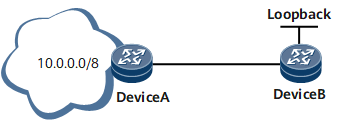Poison Reverse
Poison reverse allows a RIP-enabled interface to set the cost of the route that it learns from a neighbor to 16 (indicating that the route is unreachable) and then send the route back. After receiving this route, the neighbor deletes the useless route from its routing table, which prevents loops.
- A direct route with zero hops
- A route with Device B as the next hop and total two hops
If the route from Device A to 10.0.0.0 becomes unreachable and Device B is not notified, Device B still considers the route to 10.0.0.0/8 reachable and continues sending this route to Device A. Then, Device A receives incorrect routing information and considers the route to 10.0.0.0/8 reachable through Device B; Device B considers the route to 10.0.0.0/8 reachable through Device A. As a result, a loop occurs on the network.
With poison reverse, after Device B receives the route from Device A, Device B sends a route unreachable message to Device A with cost 16. Device A then no longer learns the reachable route from Device B, which prevents routing loops.
If both split horizon and poison reverse are configured, only poison reverse takes effect.
